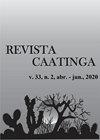传统农业甜瓜亚种质的遗传参数分析
IF 0.9
4区 农林科学
Q3 AGRONOMY
引用次数: 0
摘要
巴西的家庭农业拥有高度多样化的甜瓜种质资源,构成了育种计划的重要等位基因来源。因此,本研究的目的是根据形态参数,从家庭农民种植的不同植物品种的甜瓜亚种质中估计遗传参数并选择基因型。试验采用完全随机区组设计,分别于2019年和2020年进行,3个重复,每块5株,使用27个来自家庭农民的甜瓜子品种(S2代)和1个商业品种。评估了9个定量描述符。对方差分析的假设进行检验,然后进行个体和联合方差分析。所有被评估的描述符在子材料之间存在显著差异,遗传力高于83%,88.8%的被评估特征存在显著的基因型-环境相互作用。因此,在子品种中发现遗传变异,遗传效应优于环境效应,表明通过改善农艺利益的几个特征来获得遗传收益的可能性。推荐将BGMEL66.0、BGMEL111.0和BGMEL112.0子品系纳入育种计划,以获得良好的繁殖能力和高可溶性固溶物含量的小果实。BGMEL子材料(108.3和108.5)可以产生高产的后代,而苦瓜子材料可以产生以缩短作物周期和增大果实大小为重点的后代。本文章由计算机程序翻译,如有差异,请以英文原文为准。
Genetic parameters in melon sub-accessions from traditional agriculture
ABSTRACT Family farming in Brazil holds a high diversity of melon germplasm, composing an important source of alleles for breeding programs. Thus, the objective of this study was to estimate genetic parameters and select genotypes from a population of melon sub-accessions from different botanical varieties grown by family farmers, based on morphological parameters. Two experiments were conducted, one in 2019 and another in 2020, in a complete randomized block design, with three replications and five plants per plot, using 27 melon sub-accessions (generation S2) from family farmers, and a commercial variety. Nine quantitative descriptors were evaluated. Assumptions of ANOVA were tested, followed by individual and joint analyses of variance. Significant differences were found among sub-accessions for all descriptors evaluated, with heritabilities higher than 83% and significant genotype-environment interactions for 88.8% of the characteristics evaluated. Thus, genetic variability was found among sub-accessions, with predominance of genetic effects over environmental effects, denoting the possibility to obtain genetic gains by the improvement of several characteristics of agronomic interest. The sub-accessions BGMEL66.0, BGMEL111.0, and BGMEL112.0 are recommended for inclusion in breeding programs focused on obtaining good prolificacy and small fruits with high soluble solid contents. BGMEL sub-accessions (108.3 and 108.5) can generate progenies with high prolificacy, and sub-accessions of the variety momordica can be used for generation of progenies focused on shortening the crop cycle and increasing fruit size.
求助全文
通过发布文献求助,成功后即可免费获取论文全文。
去求助
来源期刊

Revista Caatinga
AGRONOMY-
CiteScore
2.10
自引率
11.10%
发文量
67
审稿时长
6-12 weeks
期刊介绍:
A Revista Caatinga é uma publicação científica que apresenta periodicidade trimestral, publicada pela Pró-Reitoria de Pesquisa e Pós-Graduação da Universidade Federal Rural do Semi-Árido – UFERSA, desde 1976.
Objetiva proporcionar à comunidade científica, publicações de alto nível nas áreas de Ciências Agrárias e Recursos Naturais, disponibilizando, integral e gratuitamente, resultados relevantes das pesquisas publicadas.
 求助内容:
求助内容: 应助结果提醒方式:
应助结果提醒方式:


